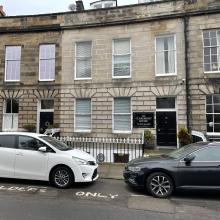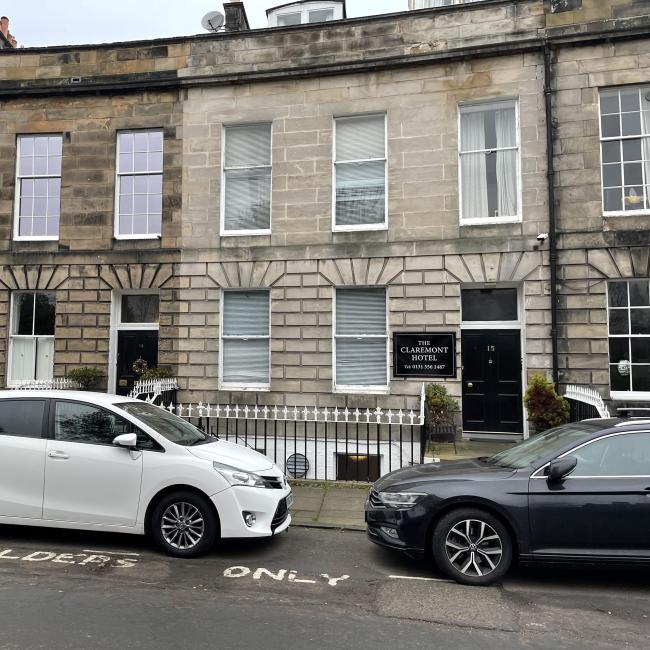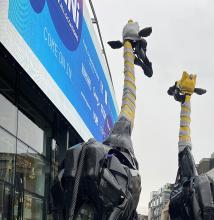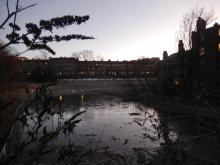
Bitter-sweet farewell
S1 Developments Ltd wants to change the use of the hotel at 14–15 Claremont Crescent and reconfigure it as seven 2-bdrm flats with two separate 3-bdrm mews dwellings and limited on-site parking for cars and bikes behind (23//070507/LBC and 23/07058/FUL).
The property comprises the two lower floors of No. 14 linked to the entire original townhouse at No. 15. Both form part of William Burns’ much altered Category-A design and were constructed around 1823.
Christopoulou McDonnell Architecture Ltd boasts of significant potential improvements to the,buildings concerned. These include:
- Separation of No. 14 from No. 15 at basement and lower-ground floors, thus reinstating the original feu plan extent of each townhouse.
- Reinstatement of No. 14’s original basement stair form.
- Reinstatement of No. 15’s original lightwell at the front.
- ‘The dramatic expanse of the crescent’s rear facade is somewhat blemished by a mid 20th-century toilet block which appears as a less than sympathetic utilitarian extension and presents a unique opportunity for potential improvement.’ The proposed improvement would replace the loos with a new extension to basement flats at Nos 14 and 15, providing ‘an attractive open aspect and direct link to the private gardens below’.
- ‘The rear portions of the gardens are in use as car parks with large areas surfaced in tarmac and gravel. An electric substation occupies a portion of the garden at No 14 and is in separate ownership and a free standing garage is cut into the grass bank in the garden to No 15. These combine to present an underwhelming backdrop to the crescent townhouses but provide considerable potential for improvement.’
- Creation of two modestly proportioned, energy-efficient, 3-bedroom mews houses, carefully aligned to minimise visual impact, with blue-green eco-roofs.
- Rationalisation and decluttering of the plan form of each storey, with spaces reflecting the building’s original internal proportions.
- ‘Comprehensive conservation and rehabilitation of the worn interior and exterior building fabric.’

Time to move on
The current bewildering warren of 19 bedrooms and corridors, staircases, Plutonian bogs and function suites, plus eccentric electrical arrangements (all perfectly legal) date from the 1960s. They have certainly looked tired over recent years.
Spurtle has not examined CMA’s plans in detail, that is to say not with the critical rigour of a trained expert. But, from what we’ve seen, on balance, these proposals constitute an ambitious, useful and overdue upgrade of this much diminished architectural asset.
The fact that comparatively few people will be able to afford the resulting homes is – in material planning terms – neither here nor there.
On that confined basis, with reservations, we welcome the application.

Farewell, old friend
In non-material terms, some residents may shed a tear with us at any passing of the Claremont Hotel and the likely return of conformity.
Years syne, its dim public bar hosted many peculiar conversations and smokey intimacies between – in infinite combination – locals and uncommunicative telephone engineers far from home, casino chancers, whisky priests, drunk poets not yet published, lonely lips and exhausted excursion leaders longing for a cheek to cry on.
Of course, even neighbours who never penetrated the hotel’s interior have still delighted in the joyous cacophony of Irish primary-school children passing from the hotel below their windows outside, early.
Who with a pulse hasn’t thrilled to the late-night roaring halloos and mating shrieks of teenaged German students, high on life, hormones and the roof?
Who won’t regret the absence of throbbing coaches, odd door-knocks at midnight, wedding guests spilling out onto the street for a smoke and a song and a snog and a punch in the chops between chums churned over by happy couples they feel existentially feckin abandoned by?
Somehow, all these elements have transposed here something of the wider world, brought sometimes a Marseilles-in-microcosm to one slumbrous offshoot of the New Town promontory. It's been a wonderful experience, even for those witnessing it safely through telescopes from East Claremont Street.
In the event of S1 Developments’ successful application, Spurtle’s kindred spirits would miss these curious social effects, and miss too – without irony – the hotel’s long-suffering management and staff who, with good grace and generosity of heart, have for so long done all in their power to mitigate them.
Overall, we think the proposal is a good thing: a sad price worth paying.



